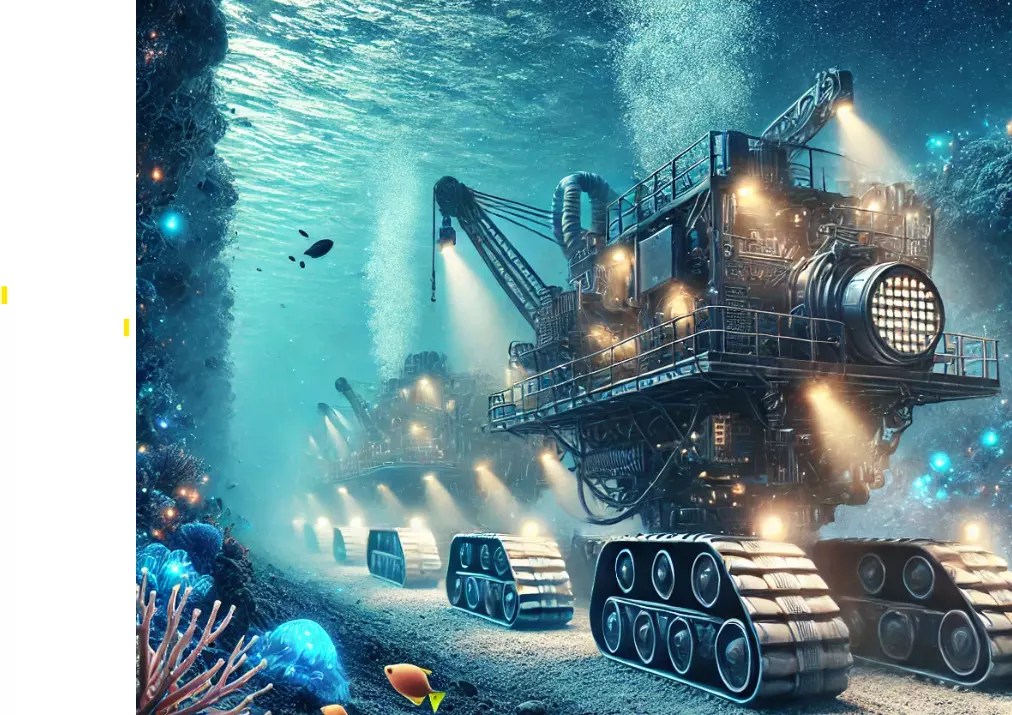Avenue for exploration
Deep sea mining — with potential to unlock critical minerals for clean energy and technological advancements — holds immense promise as a solution to depleting terrestrial resources

Oceans are a ‘common heritage of mankind’. At a significant depth of oceans, seabed contain rich minerals like manganese, cobalt, nickel, zinc and rare earth materials. The process of deep sea mining has led to discussions and debates in the international community due to its potential to meet the demands of minerals and metals, considering the fact that the terrestrial resources are depleting at a fast rate. Ocean explorations and deep sea mining have revealed the presence of polymetallic nodules, sulphides, gas etc. that can help in building a strong clean energy infrastructure. This in turn has the potential to raise the global demands of minerals by a large percentage as the world is slowly shifting towards harnessing renewable sources of energy. Deep sea includes both genetic and non-genetic (mineral) resources. Deep sea are thermocline areas where the sunshine does not penetrate the water surface. As a result, the temperatures are quite low while the pressure remains too high. This makes technological engineering in such harsh weather a big task. Limited visibility and access create difficulties in establishing a clear sea line of communication. Acidification from the vehicles can cause genetic alteration of marine organisms and introduce toxins in the marine food chain. However, despite these inequities, deep sea explorations, better data access, efficient collection technique of minerals and metals, ocean climate analysis, enable training opportunities and much more. Exploration and exploitation of the minerals in the deep sea not only comply with sustainable development goals (SDGs) because of zero-carbon content but also help in building generation techniques required to boost scientific discoveries, economic opportunities, electronic gadget production etc. In order to cater to the above mentioned issues, stakeholders need first-hand assessment, develop viable strategies and research capacity, and implement funds and resources equitably, to see and reap the benefits of a golden future in deep sea mining.
The International Seabed Authority (ISA) by virtue of United Nations Convention on the Law of the Seas (UNCLOS) 1982, authorises the exploration and exploitation of the Area beyond national jurisdiction, that is, beyond the continental shelf. The Area consists of almost 50 per cent of the whole seabed on Earth. Till date, the ISA has issued 31 contracts to explore the ocean floor. China is currently leading in deep sea mining exploration with 5 permitted contracts. Countries like Norway, Japan, the USA, France, and Germany also have the license for international seabed mining and so does India. However, international regulations for a ‘uniform mining code’ on the possibility of extraction of minerals from deep sea mining are in discourse and deliberation. The major points of discussion at the 29th session of the ISA Council meeting held in Jamaica on March 18-19, 2024 pertaining to deep sea were test mining, environmental impact assessment, safety issues, cultural heritage, funds, overfishing, biodiversity loss, acidification etc. Some of the major issues like technological challenges, lack of a coherent international framework, environmental degradation, thermal pollution and economic disparities continue to loom on designing a uniform mining code to regulate activities in the deep sea.
India is the 16th largest maritime country in the world. It has a coastline of 7,517 kms. Unlocking the marine resources from the seafloor can reveal new sources of energy, medical drugs, animal protein, scientific innovation etc. India has shown interest in deep sea mining activities with its national policy on the blue economy. The Maritime Vision 2030, launched in 2020 by the Ministry of Shipping, is an initiative under the umbrella of Blue Economy projects. It is a part of the United Nations ‘Decade of Ocean Sciences’ (2021-2030). The Deep Sea Mission was proposed by the Ministry of Earth Sciences (MoES). It is a mission mode project to support Blue Economy initiatives of the Government of India. Exploration vehicle, Matsya 6000, remains central to this mission. The mission aims to build human capacity in the field of ocean biology, develop manned and unmanned submersibles to reach depth and conduct explorations, harness offshore energy, and focus on ocean climate change advisory services to support coastal tourism.
India relies heavily on the import of valuable minerals like copper, lithium, cobalt, manganese etc. Untapped minerals from the deep sea can support indigenous technology and manufacturing industries of India. India has put in an application for Rights to Mine the Indian Ocean Seabed, which includes Cobalt-Rich Afanasy Nikitin Seamount (AN Seamount) and Carlsberg Ridge. In the coming time, the country plans to focus on the Clarion-Clipperton Zone, which is said to first show the presence of minerals. Recently, India’s largest shipyard, based in Kolkata, Garden Reach Shipbuilders & Engineers Ltd signed a control deal in Goa worth Rs 839.55 crore with the National Centre for Polar and Ocean Research (NCPOR) to build the largest Ocean Research Vessel (ORV). The vessel will assist in deploying and retrieving heavy test equipment and submersibles. She can also execute Conductivity, Temperature, Depth (CTD) profiling, geophysical seismic surveys and meteorological observations. The country has also announced to ratify the High Sea treaty as of July 2024, as it remains committed to the cause of environmental protection and conservation. The ratification of this treaty holds immense significance in terms of use of marine resources worldwide. The exploration activities are at a budding stage, it focuses on research, resource estimation, survey, and equipment funding and can further help in boosting the marine economy.
The writer is PHD Scholar, Department of International Relations, Jadavpur University. Views expressed are personal



